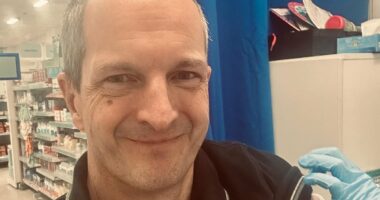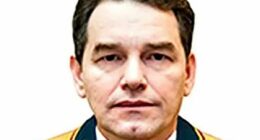Share this @internewscast.com
A forgotten nuclear legacy buried beneath a major Midwestern city may be silently fueling a devastating health crisis.
During World War II, scientists in St Louis, Missouri, produced nearly one ton of uranium every day as part of the top-secret Manhattan Project.
While much of it was shipped to labs across the country to make the first atomic bomb, anything left over was dumped in 82 locations across the city.
From there, it spilled into Coldwater Creek, a 19-mile stretch broken off from the Missouri River surrounding schools, baseball fields and cemeteries.
Eight decades later, generations of families in St Louis residents have been struck by cancer and autoimmune disorders due to the nuclear waste leeching into their water and soil.
And doctors in the area warn they are seeing younger and younger patients being diagnosed with ‘pretty significant cancers.’
Though the government has offered payments and launched clean-ups, doctors and patients have urged federal lawmakers and health authorities to investigate the disease cluster more closely.
They also warn toxins lurking in and around Coldwater Creek could move into the Missouri River, which stretches over 2,300 miles and flows through seven states.

St Louis, Missouri (pictured here), was once home to uranium production during World War II. Now, its residents are suffering from rare cancers and autoimmune diseases

The above map shows areas in St Louis County that have been plagued with clusters of rare cancers and other chronic illnesses
Dr Gautum Agarwal, a urologist at the David C Pratt Cancer Center in St Louis, told CBS News: ‘The people there deserve for us to look at this much closer than we have.’
St Louis has been nickamed the ‘Gateway to the West’ as it has long served as a transportation hub and launchpoint for westward expansion with its vast network of rivers and railroads.
While it has held the infamous title of ‘murder capital of the world,’ the city has focused on decreasing its crime rates over the past several years.
Linda Morice moved to St Louis with her family as a child in 1957. Soon after, neighbors and family members became sick.
Shortly after her mother’s death from cancer, her uncle, a physician, took her aside. ‘Linda, I don’t believe St Louis is a healthy place to live. Everyone on this street has a tumor.’
Morice told CBS News: ‘It was a slow, insidious process.’
‘It was shocking that this creek was likely making people sick,’ she added.
‘That material was in 82 different spots throughout St Louis County. It spilled. Children played in it.
‘It seemed to me that there wasn’t an attempt to absolutely get to the bottom of it.’
Morice’s father and brother also died of cancer over the next few years, and now her husband is battling the disease.
The slew of deaths caused her to look back at her childhood and wonder when the toxic exposure started.
She said: ‘All that time, all those fun things were happening, but that whole time we, and the rest of the community were being exposed to some pretty dangerous stuff.’
According to the latest data from the National Cancer Institute, St Louis County, which includes Coldwater Creek, had an age-adjusted cancer rate of 458 per 100,000 people from 2017 through 2021.
However, about 55 counties have higher rates as of 2023. St Louis County’s figures are roughly in line with the statewide rate, which was 452 per 100,000 between 2017 and 2021.
The national rate for that time period was 444 per 100,000.
Just over 6,000 of the county’s nearly 1million residents were diagnosed with cancer in that four-year period.
The latest data shows the rate in St Louis County is decreasing, but it’s unclear how much of the Coldwater Creek area is represented in theses figures.
The entire 40 tons of uranium oxide that was used to make the atomic bomb was manufactured at the Mallinckrodt industrial site in downtown St Louis, which produced 200 million pounds for the Manhattan Project.
Uranium is thought to produce radioactive alpha particles that damage DNA and increase the risk of harmful, cancer-causing mutations.
A 2019 study conducted by the Department of Health found that people living near Coldwater Creek from the 1960s to 1990s ‘could be at an increased risk of developing lung cancer, bone cancer or leukemia.’

Coldwater Creek (pictured) is labeled as one of the most polluted waterways in the US. It is connected to the Missouri River

The above map shows the cancer rate per 100,000 residents in each Missouri county between 2017 and 2021. The rate in St Louis County is 458 per 100,000 people in that four-year period
Dr Agarwal, who is treating Morice’s husband, is now tracking how many of his patients lived near Coldwater Creek.
He said: ‘I was seeing patients who are young, who had developed pretty significant cancers from areas that there’s been some contamination with nuclear waste.’
In addition to Coldwater Creek, chemicals also seeped into the nearby West Lake Landfill.
The state launched a cleanup effort last year after an Environmental Protection Agency investifation found the toxins contaminated nearby groundwater in the neighboring Bridgeton area, which sits just northwest of the St Louis Lambert International Airport.
The EPA also found excess limits in drinking water and said it would investigate whether chemicals leaked into nearby wells or if they could reach the Missouri River.
Senator Josh Hawley, a Republican, has also put forth legislation to clean up the area.
However, current efforts are not expected to be completed until 2038. Residents believe that if far too late.
Kim Visintine, founding member of advocacy group Coldwater Creek – Just the Facts Please, said earlier this year: ‘It’s almost a given in our community that at some point we all expect to have some sort of cancer or illness.
‘There’s almost this apathy within our group that, well, it’s just a matter of time.’













